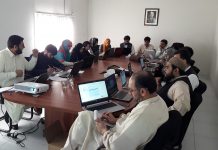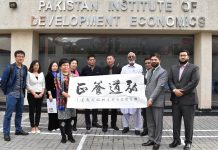Urban development opportunities in Pakistan under CPEC
- Rapid Urbanization under CPEC is creating agglomeration economy with opportunities in the sectors of real estate, urban infrastructure, construction, and municipal service delivery. CPEC projects are expected to create smart cities that would have technological and knowledge spillovers ensuring sustainability.
- CPEC brings investments from the Pakistani private sector in ‘Low-carbon Urban Transportation’ and other ‘Clean Technologies for Cities’. In this regard, private sector in Pakistan can access to the international climate finance through Green Climate Fund (GCF) and other global funding opportunities.
- CPEC an economic corridor can become an ‘environmental corridor’ if the mechanism for development of the ‘Regional Renewable Energy Trade’ between China & Pakistan is formulated & implemented. Benefiting from the Chinese experience, Pakistan can move on the path of GREEN DEVELOPMENT.
Financing sector opportunities in Pakistan under CPEC
- Financial inclusion through CPEC: Financial inclusion means that individuals and businesses have access to useful and affordable financial products and services that meet their needs- transactions, payments, savings, credit and insurance that delivered in a responsible and sustainable way” (World Bank). New International commercial Banks are coming to Pakistan, just like Bank of China has established its branch in Pakistan. It brings new and modern financial products those can support the existing financial system.
- Financial integration by bancassurance: Bancassurance is an arrangement in which a bank and an insurance company form a partnership so that insurance company can sell its products to the bank’s client base. This could be implemented by agreement of understanding and strategic alliance etc. This opportunity is purely for the financial sector firms like banks and insurance companies, which could prospectively benefit from the higher degree of financial integration within Pakistan as well as with Chinese financial institutions.
- Opportunities for consultancy and brokerage services: There are new opportunities to provide consultancy and brokerage services for Chinese and Pakistani investors. Chinese and other foreigners might be reluctant to invest in Pakistan because they are not well aware of Pakistani financial environment, so Pakistani experts (Consultants) have opportunities to provide consultancy and brokerage services to these people.
- Opportunities for real estate business: The Gwadar port city is expected to soon become one of the most in-demand real estate investment destinations in Asia. CPEC is poised to give tremendous boost to the real estate industry in Pakistan, which even otherwise, has a promising outlook, given that a 2.8% annual population growth rate (source: Federal Bureau of Statistics, 2016) entails that more housing projects will need to be established. Real estate corporations have opportunities for the housing schemes and commercial buildings.
CPEC Educational opportunities
- CPEC Consortium of Business Schools: The consortium aimed at setting the course of academic collaboration between the two countries Pakistan & China. Top 10 business schools from both countries are the part of this consortium.
- Such initiatives will reshape the relationship of the universities with society by turning the former into an active player in economic development through creating scientific technological knowledge and innovation that goes beyond mere teaching and research but application of technological knowledge for the development in various fields.
- Scholarships for Pakistani students: CPEC is like a catalyst for economic development in terms of providing educational facilities. Chinese scholarships increased to 600 a year under CPEC for Pakistani students for the year 2016-17 from all over Pakistan. Moreover, about 131 students got scholarship certificates that further enhances the education exchanges programs in the times to come.
Growing employment opportunities
- According to the international labor organization, CPEC would bring more than 400,000 jobs to the country while the Applied Economic Research Centre has estimated that the mega initiative would provide around 700,000 direct jobs between 2015 and 2030. The Planning Commission’s data shows even more promising results, with CPEC generating around 800,000 jobs in the next 15 years. Besides, there will be a positive multiplier effect and more indirect and induced jobs will be created. Pakistan is about to gain a lot from these opportunities as there would also be a noteworthy increase in the annual economic growth of the country. CPEC created job opportunities are not only for laborers but also for professionals. For instance Port Qasim Coal Power Project conscripted hundreds of engineers to be sent to China for training. Being educated in China, and acquainted with the Chinese technologies and values, Pakistan has a prodigious competitive edge with this opportunity.
Cultural Exchange Programs under CPEC
- The MoU has been signed between Suzhou Vocational University and Education Department of Gilgit-Baltistan.
- The functions of CPEC CCC are as follows: Sino-Pak Students Exchange, Academic Research and Seminar, Vocational Education, Chinese Culture Experience Camp, Teachers Exchange and so on. CPEC CCC will cultivate the talents especially for “B&R” and CPEC, it will become the Brand Program in the field of Sino-Pak education and culture communication.
- CCC has a great piece of plan which is hundred talents of personnel education plan, in this plan, at least 100 students from Pakistan will be trained in higher education in China and get job offers. As a great piece of plan in 2017, CPEC CCC will offer them free tuition for the whole study.
Tourism Opportunities under the realm of Socio-Economic Sector
- CPEC will boost tourism in 73,000 sq. km region in Gilgit-Baltistan. This will be creating job opportunities for the local people and will further multiply the income prospects of the locality of GB. This is going to benefit not only the local people but it will also transcend its positive implication to other parts of the country.
- Also, Northern areas of the country for ecological tourism and southern coast line for coastal tourism have potentials to be tapped.
Trade prospects and Potential industries
- CPEC will play a key role in enhancing the trade through shifting the mode of transportation. Currently about 86% of trade is done through sea and only 2% through land. The availability of improved infrastructure (rail and road network) will help to increase in trade through decrease in transportation and transaction cost. China is the largest trading partner of Pakistan. About US$16bn of trade with China occurs mainly through the sea (97%) and only 1% through land. A significant fraction of trade with China will be diverted to the land route after the completion of the project.
- Agriculture export receipts has dropped more than 15% for the year 2015-16. Agriculture export to China constitute 15% of total exports of Pakistan. Due to lack of linkages with manufacturing a great percentage of agrarian products are exported in the raw form. China is taking keen interest to invest in agribusiness to add value. Textile industry also lost competitiveness due to low value addition which is also considered for the investment and value addition to increase the export.
- Marble and mineral processing, food processing and packaging, and leather have great potential in maintaining the trade balance.
Industrialization and Industrial Cooperation
- The development of Special Economic Zones (SEZs) is also a mandate of Belt and Road Initiative (BRI) and in line with this, 9 SEZs are also prioritized in Pakistan. The SEZs are placed in naturally rich regions to tap the regional potential of Pakistan. These SEZs will have the potential to attract FDI, to expedite industrialization process and improve the export base for manufacturing, food and minerals processing, herbs, wood and fisheries.
- Potential Chinese industries which are interested to relocate in SEZs in Pakistan includes light engineering, footwear, leather and textile which are labour intensive and will open job opportunities for unskilled labour. Some SEZs like Mohmand Marble zone and Quaid-e-Azam Apparel Park are dedicated to add value in marble and textile products respectively and improve the export base.
- Special incentives will be given to those enterprises in SEZs which will add 20% and more value in the products and to high tech related industries.
Gwadar as Trading hub
- Gwadar Port is one of the initial and key projects under CPEC. The port is being developed to meet the international standards having a capacity of 120 berths and will be able to deal with trade traffic of about 45-65 million tons (in 15 years) up to 300 million tons (in 50 years). It will strengthen the trade ties with landlocked countries and it is estimated that up to 4 percent of global trade will pass through Gwadar by 2020.
- The revenue from Gwadar port is estimated to be $US40 billion annually. About 70% increase is expected in maritime trade through Gwadar port along with Ports in Karachi.
- Properly functional Gwadar port will promote the development of petrochemical plant, clothing factory, cement plant and automobile factory and oil refinery.
Energy Pipelines and Transmission Lines between China and Pakistan
As first phase of CPEC has been completed, now the next phase is industrialization. For industrialization there should be sustainable and secure energy. China-Pakistan can adopt Oil and gas pipeline, and transmission lines model to connect its energy base. Gwadar port will greatly enhance connectivity of other provinces and areas with Baluchistan to facilitate further development. It is very close to geographical positions of oil and gas resources in the Middle East, offering low cost and much convenience. Adjacent to booming gulf countries, it enjoys convenient and fast transportation and low transport cost and risks. Large-sized cargo ships, oil tankers and passenger liners can conveniently berth as it is adjacent to the world’s main shipping lines. As the channel of Gwadar Port is short and deep, with a big transshipment area, ship turning takes a little time.
ICT Based Smart Cities
- As first phase of CPEC has been completed, now the next phase is industrialization. For industrialization there should be sustainable and secure energy. China-Pakistan can adopt Oil and gas pipeline, and transmission lines model to connect its energy base. Gwadar port will greatly enhance connectivity of other provinces and areas with Balochistan to facilitate further development. It is very close to geographical positions of oil and gas resources in the Middle East, offering low cost and much convenience. Adjacent to booming gulf countries, it enjoys convenient and fast transportation and low transport cost and risks. Large-sized cargo ships, oil tankers and passenger liners can conveniently berth as it is adjacent to the world’s main shipping lines. As the channel of Gwadar Port is short and deep, with a big transshipment area, ship turning takes a little time.

 English
English 中文
中文












